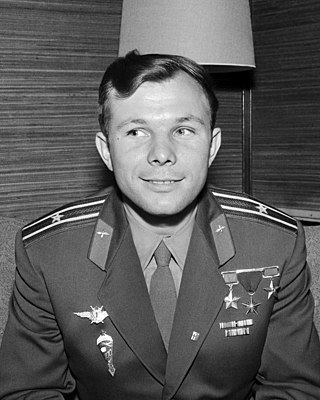
Yuri Alekseyevich Gagarin was a Soviet pilot and cosmonaut who, aboard the first successful crewed spaceflight, became the first human to journey into outer space. Travelling on Vostok 1, Gagarin completed one orbit of Earth on 12 April 1961, with his flight taking 108 minutes. By achieving this major milestone for the Soviet Union amidst the Space Race, he became an international celebrity and was awarded many medals and titles, including his nation's highest distinction: Hero of the Soviet Union.
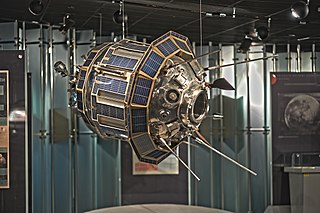
Luna 3, or E-2A No.1, was a Soviet spacecraft launched in 1959 as part of the Luna programme. It was the first mission to photograph the far side of the Moon and the third Soviet space probe to be sent to the neighborhood of the Moon. The historic, never-before-seen views of the far side of the Moon caused excitement and interest when they were published around the world, and a tentative Atlas of the Far Side of the Moon was created from the pictures.

The R-7 Semyorka, officially the GRAU index 8K71, was a Soviet missile developed during the Cold War, and the world's first intercontinental ballistic missile. The R-7 made 28 launches between 1957 and 1961. A derivative, the R-7A, was operational from 1960 to 1968. To the West it was unknown until its launch. In modified form, it launched Sputnik 1, the first artificial satellite, into orbit, and became the basis for the R-7 family which includes Sputnik, Luna, Molniya, Vostok, and Voskhod space launchers, as well as later Soyuz variants. Various modifications are still in use and it has become the world's most reliable space launcher.

Zond 5 was a spacecraft of the Soviet Zond program. In September 1968 it became the first spaceship to travel to and circle the Moon in a circumlunar trajectory, the first Moon mission to include animals, and the first to return safely to Earth. Zond 5 carried the first terrestrial organisms to the vicinity of the Moon, including two Russian tortoises, fruit fly eggs, and plants. The tortoises underwent biological changes during the flight, but it was concluded that the changes were primarily due to starvation and that they were little affected by space travel.

Rhabditida is an order of free-living, zooparasitic, and phytoparasitic microbivorous nematodes living in soil.

The Vostok programme was a Soviet human spaceflight project to put the first Soviet cosmonauts into low Earth orbit and return them safely. Competing with the United States Project Mercury, it succeeded in placing the first human into space, Yuri Gagarin, in a single orbit in Vostok 1 on April 12, 1961. The Vostok capsule was developed from the Zenit spy satellite project, and its launch vehicle was adapted from the existing R-7 Semyorka intercontinental ballistic missile (ICBM) design. The name "Vostok" was treated as classified information until Gagarin's flight was first publicly disclosed to the world press.
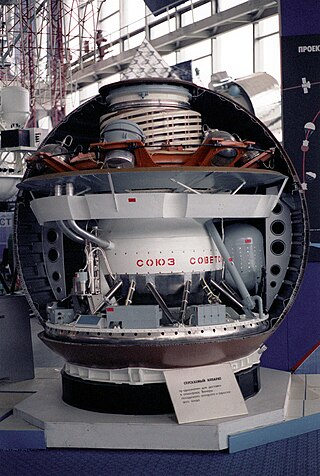
The Venera 12 was an uncrewed Soviet space mission designed to explore the planet Venus. Venera 12 was launched on 14 September 1978 at 02:25:13 UTC.
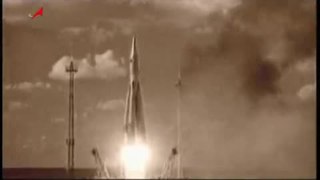
The Soviet space program was the state space program of the Soviet Union, active from 1951 until the dissolution of the Soviet Union in 1991. Contrary to its American, European, and Chinese competitors, which had their programs run under single coordinating agencies, the Soviet space program was divided between several internally competing design bureaus led by Korolev, Kerimov, Keldysh, Yangel, Glushko, Chelomey, Makeyev, Chertok and Reshetnev. Several of these bureaus were subordinated to the Ministry of General Machine-Building. The Soviet space program served as an important marker of claims by the Soviet Union to its superpower status.

Obaid Siddiqi FRS was an Indian National Research Professor and the Founder-Director of the Tata Institute of Fundamental Research (TIFR) National Center for Biological Sciences. He made seminal contributions to the field of behavioural neurogenetics using the genetics and neurobiology of Drosophila.
Shama Zaidi is an Indian screenplay writer, costume designer, art director, theatre person, art critic, and documentary film maker. She is married to director M. S. Sathyu. Shama Zaidi Was Honored with Lifetime Achievement Award at ICA - International Cultural Artifact Film Festival in 2021.
Faiz-ul-Aqtab Siddiqi is a Muslim scholar, principal of the Hijaz College, founder of Hijaz Community, founder of Hijaz Expo, national convener for the campaign for Global Civility, National Convenor of the Muslim Action Committee (MAC), President General of the International Muslims Organisation, Grand Blessed Guide of the Naqshbandi Qadri Hijazi Sufi Order, Chairman of Muslim Arbitration Tribunal, international lecturer in Islam, and a barrister at law.
Asif Azam Siddiqi is a Bangladeshi American space historian and a Guggenheim Fellowship winner. He is a professor of history at Fordham University. He specializes in the history of science and technology and modern Russian history. He has written several books on the history of space exploration.
Javed Siddiqui is a Hindi and Urdu screenwriter, dialogue writer and playwright from India. He has written over 50 storylines, screenplays and dialogues.
Kashif Mumtaz Siddiqi is a professional footballer who plays as a defender. Born in England, Siddiqi represented Pakistan at senior international level.

Mustafizur Rahman Siddiqi was a Bangladeshi entrepreneur, politician and diplomat. He set up a number of manufacturing and finance businesses during the 1960s. He played a prominent role in the Bangladesh Liberation War of 1971, organising resistance within Bangladesh and travelling to the US to represent the Bangladesh Government in exile. He became Minister of Commerce and Foreign Trade in the newly formed state, and ambassador to the US and Mexico.
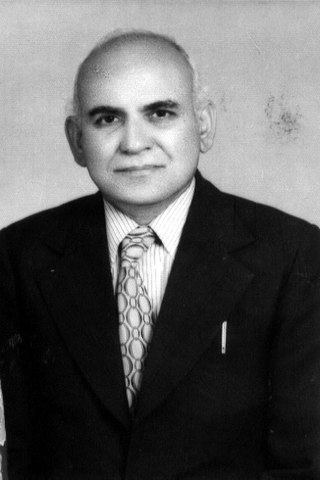
Manzoor Ul Haq Siddiqi was a Pakistani educationist, historian and an author. He served in Cadet College Hasan Abdal from 1954 until his retirement in 1980.
Paratrichodorus is a genus of terrestrial root feeding (stubby-root) nematodes in the Trichodoridae family (trichorids), being one of five genera. They are economically important plant parasites and virus vectors. The females are didelphic, and are distributed worldwide.
Trichodoridae is a family of terrestrial root feeding nematodes, being one of two that constitute suborder Triplonchida. They are economically important plant parasites and virus vectors.
Quinisulcius is a genus of nematodes belonging to the family Belonolaimidae.
The following lists events that happened during 1966 in the Union of Soviet Socialist Republics.










